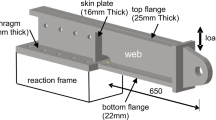Abstract
Partial penetration welding joint refers to the groove weld that applies to the one side welding which does not use steel backing and to both side welding without back gouging, that is, the partial penetration welding joint leaves an unwelded portion at the root of the welding area. In this study, we analyzed the residual stress and fracture on the thick metal plates that introduced the partial penetration welding method. According to the above-mentioned welding method, we could draw a conclusion that longitudinal stress and traverse stress occurred around the welding area are so minimal and do not affect any influence. We also performed the fracture behavior evaluation on the partial penetration multi pass welding with 25.4 mm thick plate by using the J-integral, which finally led us the conclusion that the partial penetration multi-pass welding method is more applicable and effective in handling the root face with less than 6.35 mm.
Similar content being viewed by others
References
ABAQUS User’s Manual, 2000, HKS inc.
ASTM E837-94, “Standard Test Method for Determining Residual Stresses by the Hole Drilling Strain Gage Method.”
AWS Dl. 1 Structural Welding Code.
Aoki, S., Kishimoto, K. and Sakata, M., 1982, “Elastic-Plastic Analysis of Crack in Thermally Loaded Structures,”Engineering Fracture Mechanics, Vol. 16, No. 3, pp. 405–413.
Fujita, Y. and Nomoto, T., 1972, “Studies on Thermal Elasto-Plastic Problems,”Journal of the Society of Naval Architects of Japan, Vol. 130.
Kishimoto, K., Aoki, S. and Sakata, M., 1980, “On the Path Independent Integral,”Engineering Fracture Mechanics, Vol. 13, pp. 841–850.
Masubuchi, K., 1980, “Analysis of Welded Structures,” Pergamon Press, p. 148.
Masubuchi, K., 1974, “Analysis of Thermal Stresses and Metal Movements of Weldments: A Basic Study toward Computer Aided Analysis and Control of Welded Structure,”SNAME Trans., Vol. 82, pp. 143–167.
Rice, J. R., 1968, “A Path Independent Integral and the Approximate Analysis of Strain Concentration by Notches and Crack,”Journal of Applied Mechanics, Vol. 35, pp. 379–386.
Shim, Y. L. and Lee, S. G., 1993, “Modeling of Welding Heat Input for Residual Stress Analysis,” Journal of the Korean Welding Society, No. 3, p. 112.
Shim, Y. L., 1997, “Residual Stress, Distortion, and Fracture Analysis of Welded Structures using Finite Element Method,”Journal of KWS, Vol. 15, No. 2, pp. 15–25.
Tall, L., 1964, “Residual Stresses in Welded Plates-A Theoretical Study,”Welding Journal, Vol. 43.
Ueda, Y. and Yamakawa, T., 1973, “Analysis of Thermal Elasto-Plastic Behavior of Metals during Welding by Finite Element Method,”Journal of the Japanese Welding Society, Vol. 42, No. 6.
Wilson, W. K. and Yu, I. W., 1979, “The Use of the J-integral in Thermal Stress Crack Problems,”International Journal of Fracture, Vol. 15, No. 4, pp. 377–387.
Yasuhisa, O., 1996, “Simulation of Welding Deformation by FEM,”TEAM ’96 PUSAN, pp. 593’605.
Author information
Authors and Affiliations
Corresponding author
Rights and permissions
About this article
Cite this article
Kim, S., Shim, Y.L. & Song, J.I. Residual stress and fracture analysis of thick plate for partial penetration multi-pass weldment. KSME International Journal 16, 1033–1039 (2002). https://doi.org/10.1007/BF02984422
Received:
Revised:
Published:
Issue Date:
DOI: https://doi.org/10.1007/BF02984422




